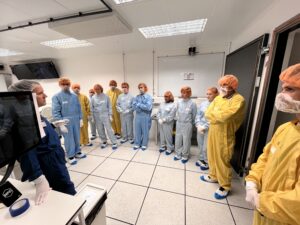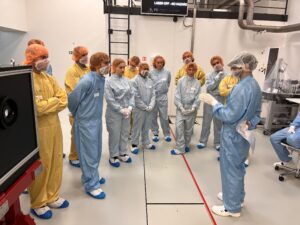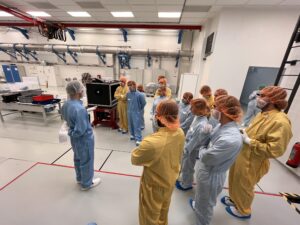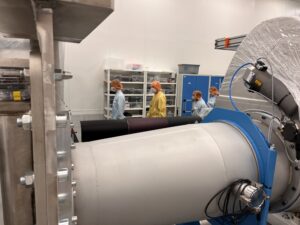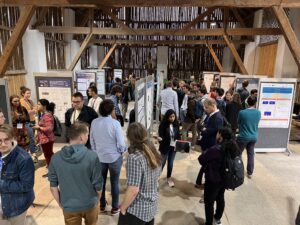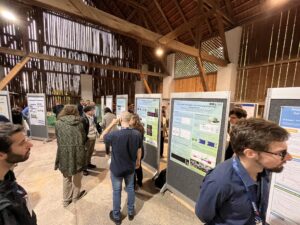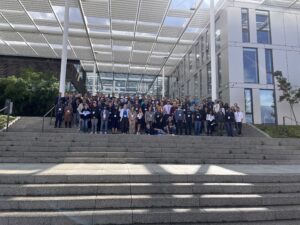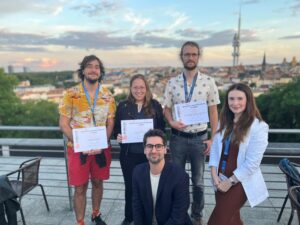More than 120 participants from 24 countries participated in the 8th edition of the ELI Summer School 2023. Hosted at ELI Beamlines in Dolní Břežany, Czech Republic, the four day programme introduced participating students to ELI and the physics and applications of laser science. Participants also had the opportunity to engage in a dynamic poster session and a range of interactives activities as well as visit the laboratories, while making new connections with other students, speakers and the ELI staff.
The 8th joint edition of the ELI Summer School series welcomed students to ELI Summer School between 29 August and 1 September to provide young scientists with a comprehensive overview of the generation and application of intense laser pulses and laser-driven particle and radiation sources. Held every single year at one of the ELI Facilities, ELISS is a key outreach activity for the Extreme Light Infrastructure to engage with students and inspire them to go into the field of laser science, as well as to support them in exploring new research topics – and a possibly a future at ELI.
This year’s school attracted an outstanding number of 120 students from 24 countries, including Poland, Germany, France, Italy and Greece, as well as China, India, Israel, Pakistan and Ukraine. As a result, ELISS 2023 was the most diverse in the history of the event series, offering opportunities to discuss and share knowledge in a broader range than ever before. The programme focused on topics, such as ultrafast imaging techniques, high-power ultrafast lasers, femtoscience, particle acceleration by lasers and applications, ultra-intense laser-matter interactions, and attoscience photonics.
“We aimed to create a programme for our students that shares the science we use in our everyday work at the ELI Facilities in a comprehensible and intriguing way,” says Anna Zymaková, Associate Researcher of the Department of Structural Dynamics at ELI Beamlines, Co-Chair of the Scientific programme of ELISS 2023. “We also hope that due to these new connections, we’ll gain scientific collaborations, users, or even colleagues in the long run. That’s how I myself joined the ELI team years back.”
Each scientific field was overviewed by distinguished lecturers from the international scientific community, representing institutes and research centres such as DESY (Germany), University College London (UK), LULI (France), SLAC National Accelerator Laboratory (USA) and FORTH (Greece). ELI and the development of large-scale laser facilities were also presented, followed by status updates from the scientific management of ELI ALPS, ELI Beamlines and ELI NP.
Besides lively social events and insightful visits to the labs, one of the highlights of the school programme was the poster session where almost 40 research works were presented by the students. Just like the participants, the topics of the showcased posters were very diverse, covering findings in the field of advanced laser-plasma research techniques, X-ray and radiation studies, high-intensity laser applications, and plasma and particle beam research. This rather informal side event provided an essential networking opportunity and offered valuable feedback for students regarding their research work.
„The poster sessions are one of the peak points of any scientific event when we get together to discuss the presented research results. This year we had many interesting posters to talk about,” says Florian Condamine, Instrument Scientist in the Department of Plasma Physics and Ultra-high Intensity Interactions at ELI Beamlines, Co-Chair of the Scientific programme of ELISS 2023. “It is also very nice to experience the passion behind the results and numbers, so we really get to know the person behind the research.”
This year, the jury announced not one but two winners of the poster competition: Michal Elkind from Israel presented her research on her poster titled “The Interaction of Intense Light with Wavelength-Scale Objects”, and Bernardo Barbosa from Portugal with his work on “Phase Control of Nonlinear Breit-Wheeler Pair Creation”. The third place was awarded to Jan Vábek from ELI Beamlines, his interesting poster was titled “Multiscale Modeling of HHG and Its Applications for Phase-matching Optimization”.
ELISS concluded on Friday, 1 September with a detailed guide about user access to the ELI Facilities given by the ELI User Office, and students had the opportunity to apply for separate hands-on activities to put theory into practice. The organising team would like to thank all the invited speakers for their valuable talks and the participating students for their active contribution to the success of the event. See you at ELISS 2024!
